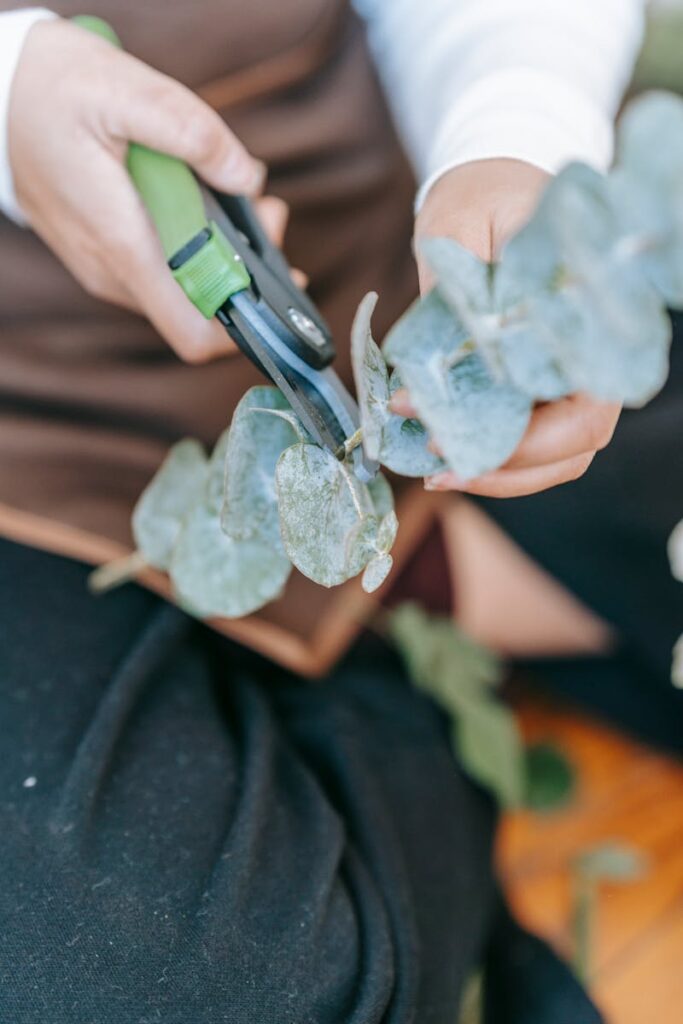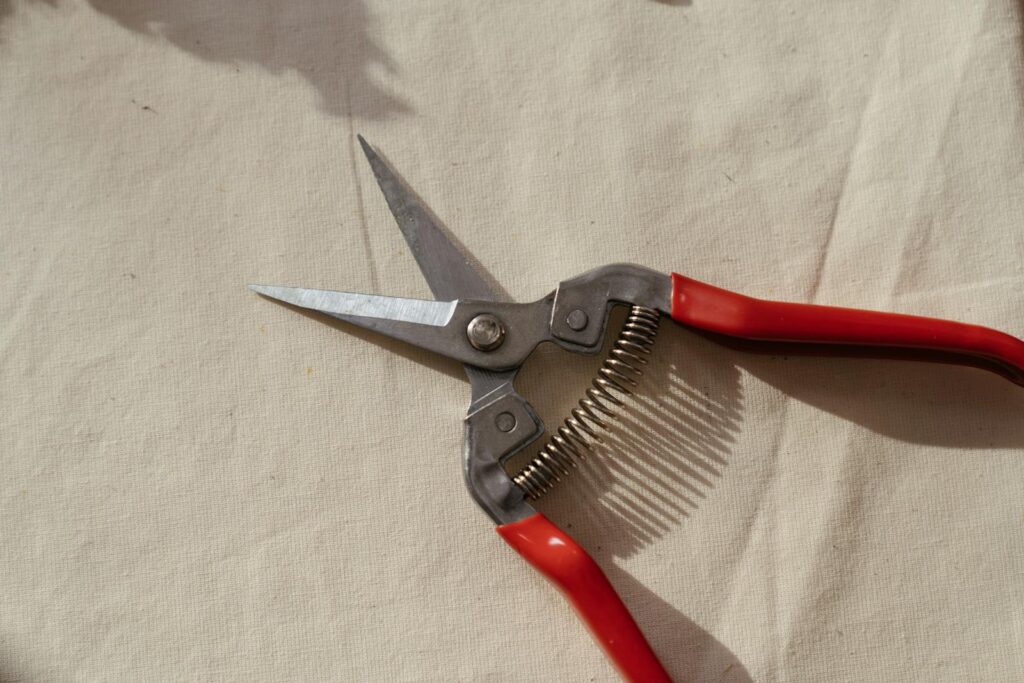
What people actually use
Selecting the right Garden Tools can save you time and money. The community of professional sharpeners have a knowledgebase of techniques for sharpening modern, high end garden tools. If someone brought me a pair of high end Swiss Secatuers, I could have them apart, sharpened, lubricated and back together in a short time. If they needed parts, which they almost never do, I could order the correct bit on line in a few minutes.
In reality, that is not always what customers use (or use often). I had a busy Spring, sharpening for gardening couples. Each customer would bring me a collection of different tools, literally filling the boot of their car. Tools ranging from small scissors to long handled edgers, loppers and ratchet pruners. You name it, they brought it. The earliest piece I encountered was a pair of shears made in the 1950’s judging by the construction. The newest piece was a pair of heavy duty secatuers that had not even been used once.
Some of the pieces had never been sharpened. Some of the pieces had been sharpened several times, while some of the pieces had been almost ruined by incorrect sharpening. I could tell by wear which pieces were favourites and which were very unpopular.
The Best Tools
The best and by far the nicest piece that was brought to me was the 1950’s pair of shears. The owner said ‘Those belonged to my dad. He sharpened them himself. Do what you can with them’. After cleaning up the light coating of rust, I had a good look at the shears. Hardwood handles. Split and repaired badly. The word ‘Birmingham’ stamped into the blade. Interesting. During disassembly I encountered bronze washers, thinner than writing paper, a proper steel nut and bolt that were nicely fitted to the hole they passed through. Some traces of ancient grease. The blade had been sharpened repeatedly using a fine hand file. Not perfect, but not improperly sharpened. I cleaned everything up and put a new edge on the blades with the Tormek machine and fine stone. I deburred the blades, then put everything back together using lithium grease a lubricant. I snugged up the bolts until the blades just contacted along the whole length.
I test everything I sharpen. I took the shears out and snipped a few yards of driveway edging. They made the ‘proper sound’ when in use. Almost musical. Wow. The owner was very pleased when she saw them. I applied some linseed oil to the handles and gave them a wipe. The shears shone as there was no rust left. I used German Ballistol to coat the outer surface of the tool and give it some water resistance. They would last at least another 75 years if cared for even slightly.
The Worst Tools
I never anticipated that part of the job was delivering bad news to customers. There are some tools that are beyond saving because they were built incorrectly at the factory or were made from unsuitable materials. An example of this is a pair of long handled edgers brought to me. The owner complained that they only cut along the first 2 inches of the tip. I took them apart and really sharpened them. I put them back together and snugged up the shears until they had the action had the correct ‘feel’. Upon testing them, I found they would only cut along the first 2 inches of the blade. Grass would just bend over and slip between the blades after the first 2 inches. I was vexed. The shears were sharp. Very sharp.
I put them together properly. I checked everything for tightness. I held them up to the light and found a large gap between the blades after the first 2 inches. The blades did not have the correct ‘bend’ to them. They were shaped incorrectly. Blades on these tools should be made of special steel which has some springing action. They should then be heat treated to make them hard without removing all of the springing action.
Americans have been using heavy truck springs to make knives since the automobile was invented. It is all about proper heat treatment. These shears were either made from the wrong steel, or improperly heat treated or both. I don’t bend customer’s blades (with the exception of scissors) as I don’t want the responsibility of ruining their tool should something bad happen. Chances are, these shears were made from cheap mild steel and given a quick bend at the factory. The bend was either inadequate from new or due to bad steel has lost its shape over time. I had to break the bad news to the customer.
I was working on a pair of big brand name secatuers that had plastic pieces over the mechanism that held them together. I accidently snapped a plastic rivet trying to take them apart. Obviously the manufacturer wanted you to throw them away when they got dull and buy a new pair. Not re-sharpen them. I carefully cleaned them up and assembled them. There was a hole in the plastic with the words ‘Oil Here’ cast above the hole. The trouble was that the hole was ‘dead ended’ and only went through the plastic, and not into the metal. You could have flooded the hole with oil and done no good what so ever to the tool.
Typically a new current pair of shears consists of the two plastic handled blades, a bolt, a lock washer, and a nut. Sometimes the nut is a ‘nylock’ with a nylon ring around the hole to keep it from loosening (falling off). The lock washer is almost always a really poor example of one, made from mediocre steel that will probably flatten on its own after a few years. The blades are usually mystery steel; sometimes hard, sometimes soft. Usually soft low carbon that will take, but not hold an edge.
In comparison, the 1950’s shears had wooden handles, blades made from nice spring steel from Birmingham, a good nut, good bolt, a pair of thick conical lock washers (think Norton motorbike), and a pair of bronze shim washers. After 70 years of use, they exhibited only exterior corrosion from hanging in a shed, but had no noticeable wear.
The OK Tools
A customer brought me a pair of mystery secateurs to sharpen. I had never seen anything like them before. After cleaning, I found that they were branded, with a European brand that still exists making tools. They also had the word ‘France’ on them under a layer of rust. There was no plastic, only stamped metal handles. They reminded me of a 1947 VW bug. That stamped steel look and feel. Probably made in the same factory as the VW. I sharpened them. The steel was good. The finish was good. The handles had the remnants of enamel (I think) on them. Not designed for comfort. I tested them. Not bad, not bad at all. Better than most Garden Centre secateurs. The mechanism was simple, but strong and provided a good positive feel. You can do delicate work with these I thought. Proper set for roses I thought. They were probably made in the 1960’s or 1970’s. They will last at least another 50 years and give the user a bit of confidence.
The Conclusion
In my own garden, I use Stihl, Felco, and Fiskars. Most of these tools were very expensive, but have lasted through a lot of hard use in our wet climate. Almost no maintenance other than a bit of lubrication. Not all of them are great. The Stihl loppers that I use are no better than any of the cheap garden centre tools that I could get. The blade forgings are rivetted to the tubular handles, giving the tool a finite life span. Once I have sharpened them for the last time, they are due for the skip.
The Fiskars tools are generally good, but have some plastic on them for the most part. They work fine, but don’t really inspire me to use them. They were just bought at a good price point. They are satisfactory.
My Felco secateurs are perfect. I use them and abuse them. I give them a little lubricant and sharpen them from time to time. They work, and if for some reason I break them, I can buy any replacement part reasonably. I use a pair of anvil type to hack bramble and cut tree branches much thicker than the tools rating. For finer work, I use a pair of bypass secateurs. The downside is that they are expensive, and I don’t want to lose them. The last time my anvil pruners went missing, it took over a year to find them again.
Not all cheap new tools are a bargain. When selecting garden tools, rather than buying new tools, perhaps one should look at the second hand market. Look for high quality tools, made in the US or Europe, or even the UK if you can find them. Do some research and sharpen the tools if you can. If not, bring it to a professional sharpener. Be happy and save money. Give the tools to your kids when you are done with them. Buy things that last forever when you can. Maintain, don’t recycle. When selecting garden tools, it is important to do your research, speak to fellow gardeners and shop around.



Leave a Reply